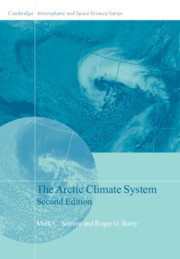Book contents
- Frontmatter
- Dedication
- Contents
- Preface
- Acknowledgments
- List of Acronyms
- List of Selected Web Sites
- 1 The Evolution of Knowledge about the Arctic and Its Climate
- 2 Physical Characteristics and Basic Climatic Features
- 3 The Basic Atmospheric and Ocean Energy Budgets
- 4 The Atmospheric Circulation
- 5 Energy Exchanges at the Surface
- 6 Precipitation, Net Precipitation, and River Discharge
- 7 Arctic Ocean–Sea Ice–Climate Interactions
- 8 Climate Regimes of the Arctic
- 9 Modeling the Arctic Climate System
- 10 Arctic Paleoclimates
- 11 The Uncertain Future
- References
- Index
- Plate Section
4 - The Atmospheric Circulation
Published online by Cambridge University Press: 05 August 2014
- Frontmatter
- Dedication
- Contents
- Preface
- Acknowledgments
- List of Acronyms
- List of Selected Web Sites
- 1 The Evolution of Knowledge about the Arctic and Its Climate
- 2 Physical Characteristics and Basic Climatic Features
- 3 The Basic Atmospheric and Ocean Energy Budgets
- 4 The Atmospheric Circulation
- 5 Energy Exchanges at the Surface
- 6 Precipitation, Net Precipitation, and River Discharge
- 7 Arctic Ocean–Sea Ice–Climate Interactions
- 8 Climate Regimes of the Arctic
- 9 Modeling the Arctic Climate System
- 10 Arctic Paleoclimates
- 11 The Uncertain Future
- References
- Index
- Plate Section
Summary
Overview
Some aspects of the atmospheric circulation of the Arctic were introduced in Chapters 2 and 3. The present chapter begins with a historical perspective. We then make use of data from the NCEP/NCAR reanalysis to provide a top-down analysis, starting with the stratosphere and moving to the tropopause, the troposphere, and the surface. The focus is largely on the mean state, aspects of seasonality, and important modes of large-scale atmospheric variability.
The stratospheric circulation during winter is dominated by a strong polar cyclonic vortex; along its margin is the polar night jet. The polar night jet decays through spring, to be replaced in summer by a weak circum-Arctic easterly flow. The winter vortex sometimes rapidly breaks down because of sudden stratospheric warmings, the effects of which can impact the troposphere and the surface. At 500 hPa, a circumpolar vortex is present year-round. The vortex is strongly asymmetric during winter, with major troughs over eastern North America and eastern Asia, and a weaker trough over western Asia. A prominent ridge is located over western North America. The lowest winter pressure heights at 500 hPa are found over the Canadian Arctic Archipelago. This asymmetry is related to orography, large-scale land-ocean distributions, and radiative forcing. The mid-tropospheric vortex weakens during spring and summer and becomes more symmetric than its winter counterpart.
- Type
- Chapter
- Information
- The Arctic Climate System , pp. 85 - 137Publisher: Cambridge University PressPrint publication year: 2014



